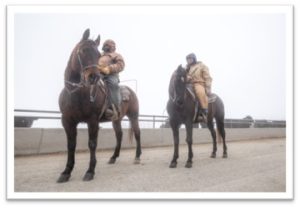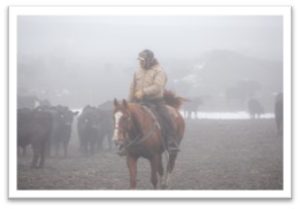1.4 Feedyard Horses
 Some feedyards have company owned horses and others allow employees to bring on their own horses.
Some feedyards have company owned horses and others allow employees to bring on their own horses.
A feedlot horse should be in good health. They need to have adequate body condition and good feet in order to hold up to the day-to-day riding required on hard surfaces and in a variety of weather conditions.
Geldings may be preferred to mares because geldings tend to have more predictable behavior. Stallions should not be used on the feedyard.
Most yards require a cowboy to have a least 3 horses that can be rotated on a regular basis. This allows for the horses to rest as they are rotated.
What is your feedyard’s policy regarding use of personal horses and the level of training required before horses can come onto the feedyard?
What support will the feedyard provide for horses that are personally owned? (shoeing, feed, veterinary care, etc)
Choosing a Horse
 The horses’ joints do not mature until they are 4 or 5 years old. This is why mature horses are preferable to younger horses. If younger horses are used, their use should be limited to only riding alleys late in the day.
The horses’ joints do not mature until they are 4 or 5 years old. This is why mature horses are preferable to younger horses. If younger horses are used, their use should be limited to only riding alleys late in the day.
Feedlot horses should be calm, moving quietly among the cattle. Their head should be down in a relaxed manner. Nervous and excitable horses will have a bad effect on the cattle being handled, causing the cattle to be nervous.
Pen riders that practice low-stress cattle handling will reduce the risk of injury to both the rider and the animals.
Review
Work through these interactive questions to review the important concepts discussed.
A male horse that has been castrated. Geldings are often preferred in feedyards and other settings because they typically have more predictable and manageable behavior compared to stallions.
A female horse that is typically over three years old. Mares are often used for breeding and riding, and their behavior can vary based on hormonal cycles.
An uncastrated male horse. Stallions can exhibit aggressive and unpredictable behavior, making them more challenging to handle and manage compared to geldings and mares.
